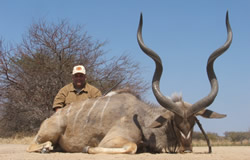


| Name | East Cape Kudu |
| Scientific Name | Tragelaphus strepsiceros |
| Average Weight Male | 227 kg |
| Average Weight Female | 157 kg |
| Shoulder Height Male | 1.4 m |
| Shoulder Height Female | 1.25 m |
| Mating Season | April/May |

Hunting Kudu remains on the top of the list for just about every hunter who comes to Africa. He is probably second only to the Impala as Africa's most sought after trophy. The Kudu is a big antelope, displaying stately bearing. He is strikingly beautiful with long spiral horns, which set him apart from all other of the antelope species. The grey ghost as he has been nicknamed sports a coat of pale-grey to brownish-grey with white vertical stripes down the flank. He has a distinctive white chevron marking between his eyes, which set off the very long spiral horns carried only by the bulls. Kudu cows look very similar to the males and while they lack horns, their ears are quite prominent. Both sexes display white beneath the tail and have a conspicuous hump on the shoulder. Hunting Kudu is best accomplished in the bushveld, where leaves, fresh sprouts, seedpods, and fresh grass are abundant.
The Kudu tends to browse in the early morning and late afternoon, usually resting during the heat of the day. Like many of the antelope species, this majestic giant tends to form family groups
of 6 to 12 individuals; mostly cows and calves, with the bulls only joining the herd during mating season. The Bulls form bachelor herds or become solitary. This is a graceful animal in flight,
extremely athletic; he can jump remarkably high for his size. In spite of those long horns, the bulls can travel at great speeds through the bush by laying their horns low along their backs.
Hunting Kudu can be extremely challenging, as the ghost is very sly, extremely elusive with exceptional senses. Look for spoor around pans and water holes as he drinks regularly and will never
be far from water. Because the depth of the curl of individual bull's horns can vary so much, trophy assessment can be difficult.
Horn length's in the low 50's are fairly common; 55 inches and over can be considered a really good trophy; and 60 inches and over is exceptional. Several methods can prove productive when hunting
Kudu. Check likely feeding areas in the early morning hours, and stalk. Ambush likely feeding areas at daybreak as the bulls return to higher ground and cover. At midday you can lie in wait on the
approaches to water, as they are regular drinkers. In addition to these techniques, consider tracking if the ground permits or try still-hunting in thick cover. While your favorite deer rifle may
be adequate, good quality controlled-expansion bullets are essential. Hunting Kudu with less than 7mm or .270 caliber rifles would not be recommended. Not especially tough, the larger calibers are
not considered necessary, however, with tongue in cheek I remind you that you can often be under-gunned, but for all intents and purposes, there is no such thing as having too much gun.
Food for thought from a fan of the big bores. As with all species, when hunting Kudu, shot placement is paramount. The neck or head shot can ruin a trophy so rule it out! The high-heart/lung shot is the ticket here. Bring your sights directly up the foreleg about one third into the body and squeeze; this shot effectively takes out the plumbing from the heart and your Kudu will not go far. A little higher will take lungs and you may have a bit of tracking to do but your Kudu will eventually go down. If your shot is placed much higher, i.e. above the half way into the body mark, you will probably be in for a long day and may even risk losing the beast. For the biltong hunter, place your shot just behind the shoulder, which will effectively take the lungs. Hunting Kudu can be most exciting and rewarding; while those 50 to 60 inch bulls can be extremely elusive, keep in mind a good representative 45 to 48 inch set of spiral horns with nice ivory tips still looks very good on the wall. Good Hunting !